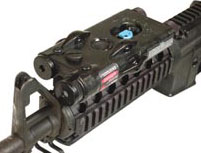| AN/PEQ-2 | |
|---|---|
 AN/PEQ-2A Aiming Light mounted on an M4 carbine | |
| Place of origin | United States |
| Service history | |
| Used by | United States Armed Forces |
| Wars | War in Afghanistan, Iraq War |
| Production history | |
| Manufacturer | Insight Technology |
| Variants | AN/PEQ-2, AN/PEQ-2A, AN/PEQ-2B, AN/PEQ-2C [1] |
| General Specifications | |
| Weight | 210 g (excluding batteries and mount) |
| IR Laser Specifications | |
| IR Laser Class | I, IIIb |
| IR Laser Output (mw) | 25 mW |
| IR Laser Divergence (mrad) | 0.3 mrad |
| IR Laser Wavelength (nm) | 830 nm |
| IR Illuminator Specifications | |
| IR Illuminator Class | IIIb |
| IR Illuminator Output (mw) | 30 mW |
| IR Illuminator Divergence (mrad) | 3 mrad to 10° |
| IR Illuminator Wavelength (nm) | 830 nm [2] |
The AN/PEQ-2 Infrared Target Pointer/Illuminator/Aiming Light (ITPIAL) is a laser sight for use on rifles fitted with a Picatinny rail. It was manufactured by Insight Technology. [3]
Contents
In accordance with the Joint Electronics Type Designation System (JETDS), the "AN/PEQ-2" designation represents the second design of an Army-Navy electronic device for portable laser combination equipment. The JETDS system also now is used to name all Department of Defense electronic systems.
